Authors
June Teufel Dreyer

June Teufel Dreyer is Professor of Political Science at the University of Miami, Coral Gables, Florida, where she teaches courses on China, U.S. defense policy, and international relations. Professor Dreyer has lectured to, and taught a course for, National Security Agency analysts, consults for organizations including the National Geographic and Centra Technology. She is a senior fellow of the Foreign Policy Research Institute and a member of International Institute for Strategic Studies.
Formerly senior Far East specialist at the Library of Congress, Dr. Dreyer has also served as Asia policy advisor to the Chief of Naval Operations and as commissioner of the United States-China Economic and Security Review Commission established by the U.S. Congress. Dr Dreyer’s most recent book, Middle Kingdom and Empire of the Rising Sun: Sino-Japanese Relations Past and Present, was published by Oxford University Press in 2016. The tenth edition of her China’s Political System: Modernization and Tradition, is scheduled for publication in 2018. Professor Dreyer received her BA from Wellesley College and her MA and PhD from Harvard, and has lived in China and Japan and paid numerous visits to Taiwan. She has served as a United States Information Agency lecturer, speaking in fourteen Asia-Pacific states. Professor Dreyer has published widely on the Chinese military, Asian-Pacific security issues, China-Taiwan relations, Sino-Japanese relations, ethnic minorities in China, and Chinese foreign policy. In 2017, she received the University of Miami’s faculty senate award as Distinguished Research Professor.
Middle Kingdom and Empire of the Rising Sun: Sino-Japanese Relations Past and Present. Oxford University Press, 2016
Articles by June Teufel Dreyer
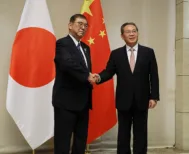
Japan - China
May — December 2024Movement but Minimal Progress
Signs of a possible improvement in Sino-Japanese relations followed a meeting between newly elected Prime Minister Ishiba Shigeru and Xi Jinping on the sidelines of Asia-Pacific Economic Cooperation (APEC) gathering in Peru on November, with the two exchanging vague promises of cooperation. Separately, China softened its position on various issues, saying that an unexpected obstruction had accidentally pushed its spy plane into Japanese airspace, allowing the resumption of imports of Nishikigoi tropical fish that had been suspended since November 2023 and reinstating visa-free entry that had been suspended in the wake of CovidCOVID. The government also indicated that it will gradually resume imports of Japanese seafood and remove a buoy in what Japan considers its exclusive economic zone, though neither has happened yet. Japanese skeptics pointed out that with no resolution on these and a number of other issues such as the detention of Japanese nationals on vaguely worded charges and sporadic violent attacks against Japanese children, it is premature to speak of Xi’s long-postponed state visit to Tokyo.
Political
While the hopeful signs mentioned above led optimistic sources in both countries to conclude that the time for improved Sino-Japanese relations had arrived, contraindications abounded. Chinese ships and planes continued to fly and sail in contested areas, and in May it was announced that a US State Department officer would be deployed to the embassy in Tokyo to work under the State’s Office of China Coordination, informally known as China House, to monitor Chinese “problematic” behavior and consider countermeasures. The position’s duties include cooperation with the Japanese government to collect more information about China’s coercive activities.

Figure 1 Japanese Foreign Minister Yoko Kamikawa, on the left, shakes hands with Chinese counterpart, Wang Yi. Photo: Japanese Foreign Ministry
On China’s part, and also in May it was announced that the Hong Kong Museum of Coastal Defense was to be converted into the Hong Kong Museum of the War of Resistance & Coastal Defense with the inauguration taking place on Sept. 3, the date marking victory in the Chinese People’s War of Resistance against Japanese Aggression (1931-45). The four existing exhibition galleries about the War of Resistance against Japanese Aggression in the HKMCD cover different parts of war history such as the Japanese invasion of China, the fall of Hong Kong, the Hong Kong and Kowloon Independent Brigade of the East River Column behind enemy lines and the fighters’ contributions, and the surrender of Japan. Such efforts, plus the attention given to Japanese behavior during World War II in school curricula are believed to be instrumental in attacks on Japanese in China. The killing of a 10-year-old Japanese boy on his way to school occurred on Sept. 18, the anniversary of the 1931 Mukden/Shenyang incident and an earlier attack on a Japanese mother and child in front of a bus taking Japanese children to school are attributed to such actions, with the Chinese government responding to criticism by saying it as simply recounting what had happened. However, the government also vitriolically condemned anti-Japanese social media with an editorial in the official Renmin Ribao stating “We will .. not accept the hype of ‘xenophobia’ and hate speech by individuals…this is unacceptable to mainstream Chinese society and to us Chinese.” Still, verbal attacks are ongoing and those netizens who attributed blame to their own government’s teachings had their posts removed from social media.
In May Chinese milk tea brand Xiang Piao Piao saw a 400% surge on its live-streaming sales in China after a netizen discovered that MECO fruit tea, a Xiang Piao Piao brand, sold products in a store in Japan with slogans on their cup sleeves showing “the ocean is not Japan’s sewer” and “0.1% of the land pollutes 70% of the ocean.” The picture was then exposed on Chinese media social platforms. In October, China’s ultra-nationalist “little pinks” called for a boycott of major milk powder company Feihe following reports that it signed a letter of intent to develop a lactoferrin-based infant formula product with Japan’s Kyowa Hakko Biochemical Co. Yet Chinese state media lined up to support Feihe, which is listed as a key research and development company in China’s 14th Five Year Plan, with a Xinhua op-ed claiming that Feihe had been “unreasonably slandered.” The conclusion was that although China has long used nationalism as a tool to build “unity” in the face of a foreign opponent, there appear to be limits on how far Beijing will allow it to go.
In a gesture of goodwill applauded by Beijing’s nationalistic Global Times, in August a Japanese foundation began Project Dongwang Xigui (“looking east, returning west”) announcing an initiative to promote the return of Chinese cultural artifacts scattered in Japan to China. Japanese musicians are increasingly popular on Chinese stages, though the driving force behind this trend is not so much popularity but a disparity in appearance fees, since Japanese artists typically command lower fees than their Chinese counterparts. Nonetheless, according to Nikkei, this suits Japan’s ambitions to tap into the lucrative Chinese market. A delegation from Fujian led by the province’s party head in July, said to be acting on the consensus reached between their respective state leaders, was described as continuing traditional friendships, further deepening the exchanges of sister-city relationships, and making new contributions to the comprehensive bilateral relationship. Japan is Fujian’s sixth-largest trading partner, fifth-largest export market and an important source of foreign investment.
In October, China and Japan held their 17th round of high-level consultations on maritime affairs in Tokyo, agreeing to make the East China Sea a sea of peace, cooperation, and friendship.

Figure 2 Prime Minister Shigeru Ishiba, left, and Chinese Premier Li Qiang shake hands before their meeting in Vientiane, Laos, on Oct. 10. Photo The Asahi Shimbun
Each side argued its case during foreign trips with, for example, separate visits to Paris by then-Prime Minister Kishida Fumio and Xi Jinping. French expert Celine Pajon characterized Xi Jinping’s visit to Paris as lacking substance, contrasting it with Kishida’s success in securing agreements on supply chains for critical minerals and beginning negotiations for a reciprocal access agreement to facilitate joint military training and exercises. She opined that although French officials tend to perceive Japan as overly aligned with the US and too assertive toward China, Japanese counterparts regard France as sometimes too yielding toward Beijing, with Pajon believing that it would make sense for France and Japan to embrace each other more closely, given the alignment of their positions. Pajon noted that Japan’s multifaceted approach toward China, which includes deterrence, counterbalancing, and conditional cooperation against a backdrop of guarding its economic security shares many similarities with the French and European de-risking stance that views China as a partner, competitor, and systemic rival.
In August, as part of a plan to diversify Central Asian states’ dependence on China and Russia, Kishida visited Central Asia in mid-August. meeting with the leaders of Kazakhstan, Uzbekistan, Kyrgyzstan, Tajikistan, and Turkmenistan. At a summit in Kazakhstan, he signaled Japan’s support for regional efforts to achieve carbon neutrality, offering technology from Japanese companies such as fossil-fuel power plants with low carbon emissions and helping the countries manufacture value-added exports, such as hydrogen and fertilizer produced with natural gas. Kishida’s agenda included discussions on a Caspian Sea shipping route linking Central Asia and Europe that bypasses Russia, which Central Asian nations have favored since Russia’s 2022 invasion of Ukraine. Japan will also provide intangible assistance such as implementing digital technology in customs procedures and encouraging countries to make use of Japan’s skilled worker program to train talent and promote person-to-person exchanges. As the report period closed, the government announced that such items as radars for vigilance and surveillance would be provided free of charge to the Philippines, Indonesia, Mongolia, and Djibouti.
According to the Wall Street Journal, many wealthy Chinese who are attracted by the low prices occasioned by Japan’s weak yen, declining economic growth in the PRC, and frustrated with Beijing’s autocratic political system, are moving to Japan. At the end of 2023, Japan had 822,000 Chinese residents, up 60,000 from 2022 this being the biggest jump in recent years. People who invest the equivalent of at least $32,000 in a Japanese business that has a permanent office and two or more employees can get a business-management visa. Beijing restricts how much its residents can take out of the country, but many Chinese buyers own companies with international operations or have overseas investments. Many have bank accounts in Hong Kong or Singapore from which they can wire money or can mobilize friends and relatives to carry cash little by little over a few months. While most are not political, Chinese officials are aware that in the early 20th century an exile group led by Sun Yat-sen attempted to mobilize support to overthrow the Qing dynasty, and worry that the current community might do the same. In November, Human Rights Watch reported that Chinese authorities are targeting and intimidating expatriates in Japan. Most of those interviewed said they had been contacted by Chinese police, who pressured them to end their activities in Japan. Some reported receiving calls from authorities through their relatives back home, while others were approached at the Chinese embassy in Tokyo. The report states that several Tibetans said they faced pressure from the Chinese government after engaging in activities to promote Tibetan culture in Japan. One Tibetan individual told HRW that when they went to the Chinese embassy in Tokyo to renew their passport, embassy officials told them they needed to return to Tibet to do so. The person said they rejected the embassy’s recommendation, fearing they would be detained or face punishment.
In November Japanese national security adviser Akiba Takeo visited China seeking to lay the groundwork for a meeting between the leaders of the two countries’ leaders though critics argued that given the outstanding issues between their countries, such a meeting was premature.
Economic
Both countries’ economies are described as fragile. The Japanese economy expanded by an annualized 0.9% in Q3 highlighting Japan’s tepid economic recovery, as domestic demand has not fully picked up while a growing risk of a slowdown in the US and further weakness in China’s economy could weigh on exports ahead. China’s economy expanded 4.6% year on year in the third quarter, slower than in the previous three months—significantly below the government’s target for full-year growth of 5%—and underlining faltering growth as Beijing stepped up efforts to boost the economy as sluggish consumption and a property slump weighed on household sentiment. In September Beijing announced its biggest monetary stimulus since the pandemic and followed up with promises of heavy fiscal spending, with economists doubting that it would have the desired effect.
Japanese investment into China declined. A survey by Japan’s Ministry of Economy, Trade, and Industry reported that Japanese companies were pulling away from China, with capital investments by local subsidiaries declining for the seventh consecutive quarter in April-June and falling below the amount invested in Europe. Reasons for the decline included the slowdown in the Chinese economy, increased competition from indigenous Chinese brands, concerns for safety after the detention of Japanese businesspeople on vaguely defined charges, and related uncertainty about the application of China’s espionage law. Employees at four Japanese companies told Asahi that some big firms had given Japanese employees and their families the option to be relocated home at the company’s expense, or are considering doing so. The executive and the employees declined to give any further details, and it is not known how many plan to take advantage of the offer.

Figure 3 Gen Nakatani and EU Foreign Policy Chief, Josep Borrel. Photo: Japan Times
In September, Mitsubishi chief executive officer Nakanishi Katsuya called for a more active strategy from the government to help Japanese companies counter increasing Chinese competition in their traditional stronghold of Southeast Asia. His comments echoed the alarm privately expressed by other executives and government officials, who fear Japanese market share in Southeast Asia is being eroded as Chinese companies increase exports and investment. Still, Mitsubishi, with $6.4 billion in annual profits, remains one of the biggest of the sogo shosha, or general trading houses, with a long history of navigating complicated geopolitical situations.
Distressed Japanese businesses provide opportunities for Chinese interests. Sovereign wealth fund China Investment Corporation was reported targeting undervalued small and midsize Japanese businesses, many of them unlisted, with the potential to thrive in China’s massive market. CIC has created an international advisory council that includes former and current executives from American and European financial institutions to show transparency but the fund provides very limited information about the companies in which it invests and there are concerns that Chinese money might eventually pose an economic security risk to Japan.
Despite continuing to lose market share to China, Japanese auto manufacturers plan to stay. Aiming to secure a 30% share of the global software-defined vehicle (SDV) sales market, against leading US and Chinese manufacturers in automotive technologies, Toyota, Honda, and Nissan agreed to promote collaboration on developing in-car software and are considering standardizing specifications for functions of car computers such as window opening and wiper movement. SDVs are next-generation cars that can add new functions and enhance abilities by updating software via the internet. Hence, they enable the company to earn money even after selling the cars, with China already boosting the development of leading-edge technologies by the standardizing application programming interface (API) that serves as the link between the software and other systems.
Large Japanese corporations with outlets in several countries were able to weather losses and regroup. Major clothing retailer Uniqlo whose parent Fast Retailing reported a large profit fall in China and Hong Kong during the three months through May by July, described itself as at a turning point with its store-opening strategy in China. Uniqlo plans a “scrap and build” policy in the PRC, closing stores with low monthly sales and opening larger ones in better locations. Meanwhile Fast Retailing nonetheless recorded a 13.5% increase in sales from a year earlier, helped by a 19.4% rise in overseas sales driven by Europe and North America.
Frosty government-to-government relations notwithstanding, both sides are aware of the interlinked nature of their economic prosperity. In May, Jiji reported that while state-level exchanges between the two remained almost halted local government were actively interacting with each other to enhance trade. There were winners and losers in the competition. In July, Nippon Steel announced that it would withdraw from a joint venture with Baoshan Iron & Steel, marking a turning point in a 21-year relationship that was a symbol of China’s progress in modernizing its steel industry. This will result in a 70% reduction in Nippon Steel’s steel production capacity in China. Chinese steelmakers, who continue to produce at high levels despite falling demand for their products as the domestic economy slows, present stiff price and quality competition, as the shift to EVs reduces Chinese demand for Japanese cars. On the other hand, factory automation supplier Fanuc raised its annual net profit outlook by $117 million on a recovery in orders from China, where government subsidies drove demand despite a sluggish economy. Demand also grew for Fanuc’s metalworking Robodrills which are used for making smartphone bodies. This occurred as Fanuc’s sales fell worldwide due to lackluster demand in Europe and Japan.
Competition did not preclude cooperation where it was mutually beneficial. On October, the People’s Bank of China (PBOC) and the Bank of Japan agreed to renew their bilateral currency swap deal amounting to 200 billion yuan (about $28.13 billion), or 3.4 trillion Japanese yen. The agreement, which aims to stabilize the financial markets of both countries and support bilateral economic and financial activities, will be valid for a three-year period and can be extended by mutual consent. In early Nov. in its first visit to China in eight years, a delegation of the Japan Association of Corporate Executives (Keizai Doyukai) asked China to exempt short-term visitors from visa requirements (later granted) and called for China’s active participation in the 2025 Osaka-Kansai Expo. Regional organizations also visited. As the report period closed, a delegation from Kansai Economic Federation (Kankeiren) visited. While affirming its desire to trade also advised China to learn from the deflation that Japan experienced over the past 30 years and asked that China expand domestic demand to improve its business environment.
Defense

Figure 4 Defense Minister Gen Nakatani attends the NATO defense ministers’ meeting held in Brussels on Oct. 17. Photo: The Asahi Shimbun, Nen Satomi
Both sides advanced their military capabilities with China facing resistance over its claims in the East China and South China seas and Taiwan and Japan principally worried about its control over the Diaoyu/Senkaku Islands and the effect that a PRC invasion of Taiwan would have for it.
Chinese media touted the debut of its J-35A stealth jet at the Zhuhai airshow. A variant, the J-35, is designed for use on aircraft carriers. With the J-35A joining the J-20 in service, China became only the second nation in the world to operate two different fifth-generation stealthy fighters: the US flies the F-22A Raptor and F-35 Lightning II. A variety of other weapons including a 10-ton drone mothership said to be capable of launching drones in mid-air and then managing them to carry out operations was also exhibited. Further raising anxieties was the expansion of the PRC’s nuclear arsenal, now believed to total 500 warheads with over a thousand expected by 2030.
In May the Japanese government announced the creation of a new Japanese research center to develop both transformational breakthrough technologies and civilian applications for defense technologies during peacetime. Modeled on institutions such as the US Defense Advanced Research Projects Agency (DARPA) and the Defense Innovation Unit based in Silicon Valley, the center will research new, more sensitive methods to detect submarines from a distance using subatomic particles and electromagnetic waves, since conventional sonar has become less effective following technological improvements that have made subs quieter.
Japan’s 2024 Defense White Paper stated inter alia, that Japan is facing the most severe and complex security environment since the end of World War II, and that it could not be ruled out that a serious situation similar to Russia’s aggression against Ukraine may occur in the Indo-Pacific region, particularly in East Asia, adding that China was intensifying its activities across the entire region surrounding Japan, including in the East China Sea, particularly in the area around the Senkaku Islands, the Sea of Japan, and the western Pacific Ocean and extending beyond the so-called first island chain to the second island chain.
In terms of weapons upgrades, in Sept. the Japanese defense ministry signed contracts for two Aegis-equipped vessels, to play a central role in ballistic missile defense. They are also expected to carry an improved version of the Type 12 surface-to-ship guided missiles to provide powerful counterattack capabilities, as well as missiles that can intercept hypersonic glide vehicle weapons. The ministry also plans to build a satellite constellation network for guided missiles to replace the current satellites which cannot be used to lock onto moving targets. The intent is to strengthen the nation’s information-gathering capabilities. Japan also aims to enhance production capabilities of hypersonic guided missiles and to acquire an improved version of the Type 12 surface-to-ship guided missiles. Deployment of US-made Tomahawk cruise missiles and other new weapons will begin in fiscal 2025. Other budget requests will enhance production capabilities for hypersonic guided missiles and acquire an improved version of the Type 12 surface-to-ship guided missiles. And, to improve its ability to deal with Chinese encroachments in the East China Sea including the area around the Senkaku Islands, the coast guard is to construct its largest-ever multipurpose patrol vessel, to function as an offshore base capable of carrying a number of small boats and to deter incursions onto the islands. However, Japan’s military capabilities continue to be bedeviled by personnel problems. Despite generous enhancements to enlist, the SDFs recruitment in 2023 was barely over half the desired number.
With far fewer financial resources to commit to defense than China and hindered by vocal, though diminishing, voices of opposition on military budgets, Japan reached out to like-minded countries for partnerships. Principal among these was the United States. At the end of July, warning that China’s aggressive posture posed the “greatest strategic challenge” in the Indo-Pacific region and beyond, the US and Japan outlined the most significant upgrade to their joint military alliance since 1960. Coordination between the allies had long been hampered because, although roughly 50,000 US military personnel are based in Japan, US Forces Japan lacked command and control authority, with its authority limited to supervising Japan-US joint training exercises and managing troops. Tokyo had to deal with the US Indo-Pacific Command in Hawaii, which is 19 hours behind Tokyo and 6,500 km away. The upgrade involves placing a three-star commander with accompanying staff in Japan, and the USFJ will be reconstituted as a joint force headquarters to allow the two militaries to co-operate and plan more seamlessly, particularly in a crisis such as a Taiwan conflict. Japan had requested a four-star commander but since US military units based in Hawaii and Guam would be the main force in the event of a crisis such as a Taiwan contingency, the ultimate command authority for US forces in Japan will remain with the Indo-Pacific Command, whose commander will likely be the counterpart of the head of the Japan’s SDF Joint Operations Command. The Kishida administration, wanting to demonstrate the strength of the Japan-US alliance in response to developments in China and North Korea, expressed satisfaction that the operative commander who is responsible for Japan’s defense will actually be stationed in Japan.
Strengthening ties with multinational organizations was also on Japan’s agenda. To China’s displeasure, Kishida attended the annual NATO meeting, with Foreign Ministry spokesperson Lin Jian saying that Japan must not interfere in China’s domestic affairs and act as a “vanguard” of NATO’s Asia-Pacific expansion. Japan has also hinted that it would like to join the Five Eyes intelligence sharing agreement of Australia, Britain, Canada, New Zealand, and the US. However, apart from Japan becoming the only non-Anglophone member, there are concerns about its ability to safeguard secrets. As Kishida’s successor, Ishiba has come out in favor of the formation of an Asian NATO. though Biden administration officials reacted coolly with Daniel Kritenbrink, assistant secretary of State for East Asia and Pacific affairs, saying “it’s too early to talk about collective security” in the region…“We’re continuing to build this network of formal and informal relationships and then we’ll see where that goes to.” Ishiba has also suggested that Japan could be added to ANZUS as JANZUS.
Support from other countries continues to be sought. In May, a meeting of the defense chiefs of Australia, Japan, the Philippines, and the US issued a joint statement expressing serious concern over China’s “repeated obstruction of…freedom of navigation” in the South China Sea. Japan and the Philippines are discussing a reciprocal access agreement (RAA) that will facilitate exchanges between their militaries similar to an agreement concluded last year between Japan and Australia. At the same time, Kishida met French President Emmanuel Macron and agreed to start formal talks on a reciprocal troop access deal and strengthening military cooperation amid rising maritime tensions in the Indo-Pacific region and the war in Ukraine. Reciprocal access agreements (RAAs) make the entry of foreign personnel and equipment easier for the visiting force. France has territories in the Indo-Pacific and stations armed forces in the region, where it has sought to develop its presence, and wants to can play a bigger role in Japan’s defense industry as Kishida adopts a more muscular military policy in the region. The Italian Navy’s aircraft carrier Cavour and frigate Alpino arrived at the MSDF base in Yokosuka to conduct joint training exercises with the MSDF in response to China’s increasing maritime presence In August, ships from Canada, New Zealand, Singapore, Italy, called at the Yokosuka base. Germany also expressed concerns, with Rear Adm. Axel Schulz, commander of the German navy’s 2nd Flotilla, telling Nikkei that although Germany has no overseas territories, a conflict in the Asia-Pacific would have massive adverse consequences since it is a major export nation, and that it intended to strengthen ties with Japan.
Japan also reached out to support smaller nations to resist Chinese encroachment. It has sent the Maritime Self-Defense Force and coast guard to the Marshall Islands to help improve the Marshallese coast guard’s capabilities through joint drills and other activities. This marked the first time that the MSDF and the JCG jointly landed on a Pacific island nation to offer such assistance. The China-leaning South China Morning Post described then-Foreign Minister Kamikawa Yoko’s 10-day tour to Madagascar, Ivory Coast, Nigeria, Sri Lanka, and Nepal as aimed at selling itself as the Global South’s China counterweight against China’s aggressive maritime expansion. Among other results was an announcement that the Japanese government will provide Sri Lanka with a vessel and sonar system worth about ¥1 billion ($6.6 million) in total as Kamikawa emphasized Japan’s position on realizing a free and open Indo-Pacific and demonstrated support for Sri Lanka, which sits in a strategic position along sea lanes. China has been making advances into the Indian Ocean in recent years.
The Future

Figure 5 LDP Diet member Nikai Toshiro shakes hands with Zhao Leji, chairman of the Standing Committee of the National People’s Congress, in Beijing on Aug. 28. Credit: Kyodo, accessed at Nikkei, Aug. 28, 2024.
Whether these hopeful signs will result in warmer Sino-Japanese relations remains to be seen. Even if Xi Jinping pays the state visit that Tokyo has long desired, Ishiba, due to his party and its coalition partner losing their majority in the Diet, will be in a weak negotiating position. He is known as a defense hawk which will give Xi little incentive to remove the offensive buoy, resume seafood imports, or reduce even temporarily the tempo of Chinese encroachments in the East China Sea. Conversely, Ishiba has little leeway to concede to China on territorial issues and Taiwan. The most likely outcome is a continuation of efforts to manage tensions rather than resolve underlying issues.
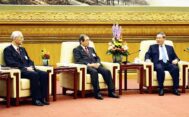
Japan - China
January — May 2024Sullen Stasis
There were no high-level visits this reporting period with each side continuing to reiterate its stance on key issues—China’s dissatisfaction with Japan’s discharge of allegedly radioactive water into the Pacific, disagreements over the sovereignty of the Diaoyu/Senkaku islands, Tokyo’s concern with nationals detained in China on vague spying charges, resentment over China’s ban of marine exports from Japan, and concerns with Chinese cyber hacking. Japanese leaders increased their willingness to acknowledge that China is the principal threat not only to Japan but to the world. Beijing continued to denounce Japan, sometimes as a pawn in US plans to thwart China’s rise, sometimes as motivated by a desire to re-create the militant expansionist empire that led to World War II. Japan became increasingly active in international diplomacy and, while declaring fealty to the one-China policy, moved closer to Taiwan. Public opinion in both countries remained hostile toward the other.
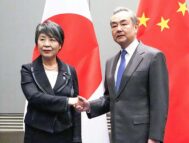
Japan - China
September — December 2023The Sparring Continues
Several senior-level contacts failed to narrow the gap between Japan and China. Xi Jinping and Kishida Fumio met at APEC for 65 minutes in November to discuss topics including a buoy placed in what Japan regards as its territorial waters, China’s lack of cooperation on North Korea’s nuclear program, Beijing’s resumption of drilling in a disputed section of the East China Sea, and the detention of Japanese nationals on vaguely worded charges. China complained about Japan’s enhanced defense relationship with the US and other countries, its chip alliance with the US aimed at excluding China, the continued release of allegedly contaminated water from the disabled Fukushima plant, as well as Japan’s support for Taiwan. There was no resolution of any of these issues. Komeito leader Yamauchi Natsuo visited Beijing with a letter from Kishida; its contents have not been publicly disclosed but it had had no discernible results. Foreign Minister Kamikawa Yoko’s meeting with counterpart Wang Yi at a trilateral meeting of foreign ministers in South Korea, also in November, was similarly unproductive. With Kishida seemingly losing support of his own party and likely to be replaced soon, Japan has little leverage in negotiations.
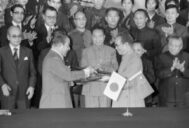
Japan - China
May — August 2023From Talking Past Each Other to Barely Talking
China’s mid-August decision to allow group travel to Japan days ahead of the 45th anniversary of the Treaty of Peace and Friendship between the two nations as well as indications that China would be open to a meeting between Xi Jinping and Fumio Kishida on the sidelines of the Group of 20 (G20) leaders’ summit in India in September gave hope for improvement in China-Japan ties. The optimism proved short-lived. Chinese media responded that Japan would first have to turn away from following the US lead, stop encouraging Taiwanese pro-independence forces, and strictly abide by the four communiques signed between Beijing and Tokyo. China’s protests over Japan’s release of radioactive water culminated in a total ban on Japanese marine products. The PRC also expressed annoyance with Japanese restrictions on the export of computer chips, the ministry of defense’s release of its annual Defense of Japan 2023 white paper, Tokyo’s closer relations with NATO, and its tripartite agreement with South Korea and the US. Japan expressed uneasiness with Russia-China cooperation and became concerned with renewed Chinese interest in Okinawa, with its purchases of Japanese land, cyberattacks, and its refusal to import Japanese seafood products.
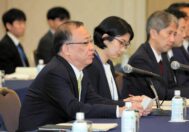
Japan - China
January — April 2023Talking—But Talking Past Each Other
The 17th China-Japan Security Dialogue resumed in late February after a four-year pause but produced no resolution to outstanding problems. In early April, Chinese and Japanese foreign ministers also met for the first time since 2019, with the four-hour meeting similarly unproductive. The Chinese side expressed annoyance with Tokyo for its cooperation with the United States, its support of Taiwan, the release of Fukushima nuclear-contaminated wastewater into the ocean, and Tokyo’s recent restrictions on semiconductor equipment exports. The Japanese foreign minister sought, but did not obtain, information on a Japanese national who had been arrested on spying charges, complained about Chinese intrusions into the territorial waters around the disputed Diaoyu/Senkaku Islands, and stressed the importance of stability in the Taiwan Strait. There was no mention of the long-postponed state visit of Xi Jinping to Tokyo as a matter of reciprocity for former Prime Minister Abe Shinzo’s visit to Beijing.
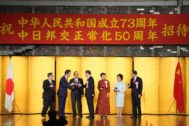
Japan - China
September — December 2022A Period of Cold Peace?
In the sole high-level meeting in the reporting period, on the sidelines of the APEC meeting in Bangkok in November, General Secretary/President Xi Jinping and Prime Minister Kishida Fumio essentially talked past each other. At an earlier ASEAN+3 meeting in Phnom Penh, Premier Li Keqiang and Kishida not only talked past each other but pointedly walked past each other. There was no resolution of major issues: the Chinese position is and remains that Taiwan is a core interest of the PRC in which Japan must not interfere. Japan counters that a Chinese invasion would be an emergency for Japan. On the islands known to the Chinese as the Diaoyu and to the Japanese as the Senkaku, Tokyo considers them an integral part of Japan on the basis of history and international law while China says the islands are part of China. On jurisdiction in the East China Sea, Japan says that demarcation should be based on the median line and that China’s efforts at unilateral development of oil and gas resources on its side of the median are illegal. Beijing does not recognize the validity of the median line.
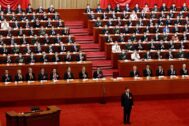
ROUNDTABLE
October 26, 2022China’s Foreign Relations After the Party Congress
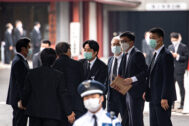
Japan - China
May — August 2022Few Positive Signs and Much Negativity
The tone of China-Japan relations became more alarmist on both sides with long-anticipated plans to commemorate the 50th anniversary of the normalization of diplomatic relations still clouded with uncertainty. Several related events were canceled or postponed sine die.
Internationally, Prime Minister Kishida was exceptionally active, attending meetings of the Quad, the G7, NATO, and Shangri-La Dialogue, where he delivered the keynote address. A common theme was attention to a Free and Open Pacific (FOIP) and the need for stability in the region, both of which Beijing sees as intended to constrain China. At NATO, Kishida met with US and South Korean representatives for their first trilateral meeting in nearly five years and suggested the possibility of joint military exercises.
Meanwhile, China continued pressure on Taiwan and the contested Diaoyu/Senkaku Islands. Although Foreign Minister Wang Yi and State Councillor Yang Jieqi were active internationally, Xi Jinping himself has not ventured outside the Chinese mainland since January 2020 save for a brief, tightly controlled visit to Hong Kong, which is unquestionably part of China. Speculation ranged from concern with his health to worries that he might be toppled by unnamed enemies—who these enemies are and what degree of influence they wield are the topics of much discussion, since Xi has through selective arrests of potential rivals and the country-wide imposition of his thoughts, effectively silenced public expression of dissident opinions.
After former Prime Minister Abe was assassinated on July 8 in an incident unrelated to foreign policy, the Chinese government sent condolences, though no Chinese representative attended the wake. A state funeral is to be held in the fall, with much speculation on who will represent the PRC.
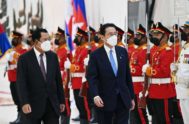
Japan - China
January — April 2022The Cold Peace Continues
Intermittent declarations of intent to celebrate the 50th anniversary of the normalization of relations notwithstanding, China-Japan tensions continued unabated. No high-level meetings were held between the two, but rather between each and its respective partners: China with Russia, and Japan with members of the Quadrilateral Security Dialogue as well as separately, with Australia, New Zealand, and the United States. All of the latter had apprehension over Chinese expansionism as their focus. Both the Chinese and Japanese economies sputtered in response to COVID lockdowns and the rising cost of energy but trade relations were robust and expected to increase as the number of new COVID cases declines. However, each side continued to develop its military capabilities, with China continuing to voice irritation with Japan for its obvious, though largely tacit, support for Taiwan’s autonomy.
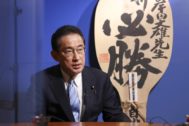
Japan - China
September — December 2021Red Lines Are Tested
Chinese Communist Party leader Xi Jinping’s long-expected and often postponed—even before the pandemic—state visit to Japan was not even spoken of during the reporting period. In the closing days of the year, the defense ministers of the two countries met virtually but, at least according to published accounts, simply reiterated past positions and hopes for cooperation in the interests of regional stability. Japan did not receive the assurances it sought on the implications of the PRC’s new Coast Guard law. China repeatedly pressed the Japanese government for support for the Beijing Winter Olympics, expressing dissatisfaction with the lack of official representation announced by Tokyo. Although trade was brisk, economic growth in both countries remained impacted by quarantines and the uncertain investment climate in China. China complained about closer Taiwan-Japan relations